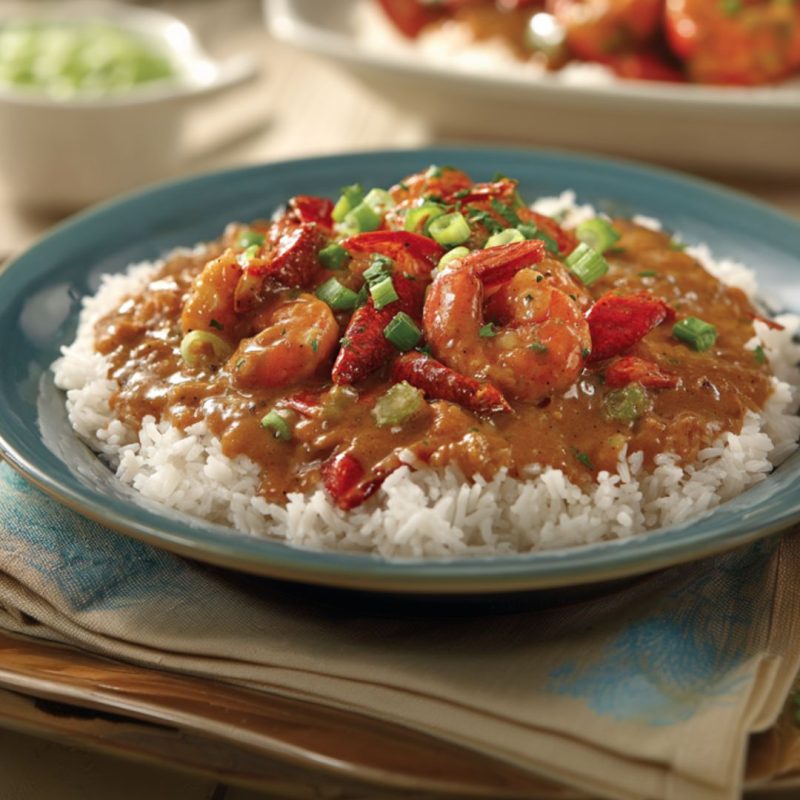Pappadeaux’s Crawfish Étouffée: A Steamy Love Letter to Louisiana Flavor
There’s something about Louisiana food that makes you feel like you’re breaking the rules—in the best way possible. It’s buttery. It’s spicy. It’s unapologetically messy. And nowhere does that ring truer than with a heaping bowl of crawfish étouffée, inspired by the legendary version served at Pappadeaux Seafood Kitchen.
If you’ve ever dined at a Pappadeaux (and if you haven’t, fix that), you know they don’t mess around. Their menu reads like a roll call of Southern soul: blackened catfish, shrimp and grits, dirty rice, and of course, their velvety crawfish étouffée. Lucky for us, you don’t need to book a flight to New Orleans or hunt down a Pappas-owned restaurant. I’ve cracked the code—and you can now recreate that bold, buttery magic right in your own kitchen.
Étouffée vs. Gumbo: Let’s Clear the Roux-mors
If you’ve ever found yourself whispering, “Wait, is étouffée just gumbo’s bougie cousin?”—you’re not entirely wrong. But the difference lies in texture, attitude, and the amount of sass packed into each spoonful.
Gumbo is a brothy, stew-like dish, typically made with a dark roux, okra or filé powder, and a mix of proteins like sausage, chicken, and seafood. It’s ladled over rice and built to feed a crowd—especially the kind that rolls in during Mardi Gras and doesn’t leave until someone plays a washboard.
Étouffée, on the other hand, is more refined. Think of it as gumbo’s creamier, thicker, and slightly more elegant sibling. The word “étouffée” literally means smothered in French, and that’s exactly what you do—smother those seasoned crawfish tails in a luxurious, gravy-like sauce and let them simmer to perfection.
Pappadeaux Roots & Cajun Royalty
Pappadeaux isn’t just another chain restaurant. It’s a Texas-born seafood dynasty with deep Louisiana roots, known for honoring Cajun and Creole cooking traditions while serving up oversized portions with flair. Their crawfish étouffée is a customer favorite, and for good reason—it’s a warm hug from the bayou, served with a side of buttery rice and a healthy dash of Tabasco.
My version stays true to the original with a homemade dark roux, a trinity of sautéed onion, celery, and bell pepper, and the unmistakable kick of Tony Chachere’s Creole seasoning. Toss your crawfish in it, let them soak up the flavor, then simmer them low and slow until your kitchen smells like Bourbon Street.
Laissez les bons temps rouler, baby.
Whether you’re throwing a Mardi Gras party or just need a little Southern comfort in the middle of a hectic week, this Pappadeaux-style crawfish étouffée delivers every single time. It’s spicy, buttery, rich, and completely irresistible.
So grab your rice, a ladle, and maybe a bottle of something cold, because once this hits the table—the good times are gonna roll!
Ingredients
- This rich, soulful crawfish étouffée brings the deep flavors of Louisiana right to your kitchen. It’s inspired by the beloved dish served at Pappadeaux Seafood Kitchen, and built from scratch with a dark roux, fresh vegetables, and tender crawfish tails. Serve it over white rice for the ultimate Southern comfort meal.
- Ingredients:
- Crawfish tails – 2 pounds, peeled and cleaned
- Butter – ½ cup (1 stick) + 2 TBL.
- Tony Chachère’s Creole Seasoning
- All-purpose flour – ¼ cup
- Onion – 1 cup, finely diced
- Celery – ½ cup, finely diced
- Green bell pepper – ½ cup, finely diced
- Garlic – 3 cloves, minced
- Seafood or chicken stock – 2 cups
- 1 Bay leaf
- Pinches of dried thyme, oregano, and rosemary
- Black pepper – to taste
- Green onions, fresh parsley, cooked white rice, and Tabasco Hot Sauce – for serving
Instructions
Season the Crawfish
Start by tossing your crawfish tails in a generous amount of Tony Chachere’s Creole seasoning. Mix well to coat every bite, then cover and refrigerate while you prepare the rest of the dish. This gives the seasoning time to soak in and build flavor.
Make the Roux
In a heavy-bottomed skillet or Dutch oven, melt ½ cup of butter over medium-low heat. Once melted, whisk in the flour. Stir continuously and patiently as the roux darkens. You’re aiming for a deep brown color — think milk chocolate. This process usually takes 15 to 20 minutes. Keep the heat steady and don’t walk away — roux can burn quickly. Once it reaches the desired color, remove it from the heat and set aside.
Sauté the Vegetables
In a separate large skillet or pot, melt 2 tablespoons of butter over medium heat. Add the diced onions, celery, and bell pepper. Cook until the vegetables are soft and fragrant, about 5 to 7 minutes. Stir in the minced garlic and sauté for another minute until aromatic.
Simmer the Stock
Pour in the seafood or chicken stock and add the bay leaf, thyme, oregano, rosemary, and pepper. Stir well to combine and bring to a simmer. Let this cook for 5 minutes to allow the flavors to blend.
Whisk in the Roux
Slowly whisk in the roux you made earlier, a little at a time, stirring constantly to create a smooth, rich sauce. The mixture should thicken to a gravy-like consistency. If it gets too thick, add a splash more stock or water to loosen it up. Taste and adjust the seasoning if needed.
Add the Crawfish
Remove the crawfish from the fridge and stir them into the simmering étouffée. Let everything cook together over low heat for about 10 minutes, just until the crawfish are heated through and the sauce is silky and well-blended.
Serve and Garnish
Spoon the crawfish étouffée generously over a bed of steamed white rice. Finish each bowl with chopped scallions, fresh parsley, and a few dashes of Tabasco for that classic Southern heat.
FULL VIDEO TUTORIAL:

